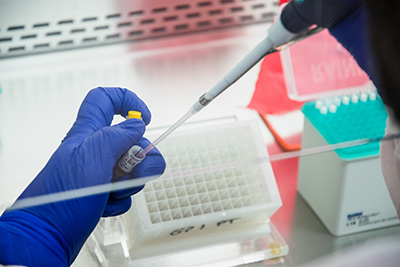
It has all the makings of a limited television series on Netflix. Just how did two Iowa State University alumni solve a whodunit worthy of a James Patterson novel?
Veterinarians, diagnosticians and producers were baffled early this year when dairy cattle in multiple Texas herds were suddenly producing less milk. And what milk was produced was abnormal and thick. The cows had also seemingly lost their appetites.
Enter Iowa State DVM graduate #1 – Dr. Barb Petersen (’09), the owner and operator of Sunrise Veterinary Service, an ambulatory veterinary practice serving dairy and beef cattle, heifers, and calves in the Texas Panhandle.
“A veterinarian friend asked me if I had noticed adult cows with pneumonia and/or diarrhea, which I wasn’t seeing,” Petersen said. “Then I had a client with cows presenting very thick, yellow milk and they were experiencing lower milk production.”
As the calendar turned to spring, other dairy clients of Petersen were noticing the same thing, a milk that had a colostrum-like appearance to it. At first Petersen thought the cause might be the herds’ feed, but tests produced no definitive results.
But like a good private investigator, Petersen continued to search for an answer. Clients were reporting sick and dying birds and then ill and dead cats at the dairies.
“The cats really threw me for a loop,” Petersen said. “They were blind, stumbling, circling, not grooming themselves and had a discharge coming from their eyes and nose.”
Enter Iowa State DVM graduate #2 – Dr. Drew Magstadt (’11), clinical associate professor and diagnostic pathologist at Iowa State’s Veterinary Diagnostic Laboratory. Magstadt was aware of what was happening in Texas but was stumped by what was causing the issues.
Petersen and Magstadt were on a series of USDA conference calls designed to connect veterinarians, diagnosticians, state animal health officials, academic and university officials, and the animal agriculture industry.
“After one of these Zoom calls, Barb and I got together for a one-on-one discussion,” Magstadt said. “It was her
observation about the cats at the dairies that led us to test for high path avian influenza.”
Since bird flu was already known to be detected in Texas and that cats were susceptible to Avian Influenza, Magstadt wondered if that could be the cause.
Petersen sent milk and tissue samples to Iowa State, and it didn’t take long for Magstadt and the VDL team to confirm the theory. The cows’ milk tested positive for Influenza A.
“People come to the VDL with questions that we try to answer, “Magstadt said. “In these situations, it’s a little bit like detective work. You find that one piece of information to solve the problem. In this case, it was the cats. Before Barb observed that, we had no reason to test the milk.”
Once the discovery was made, the story went viral. Magstadt was interviewed by countless media outlets including the New York Times, CNN, and Bloomberg News, while Petersen was interviewed by the Associated Press, Science Magazine, Iowa PBS, and Bovine Veterinarian. Magstadt and Petersen have been asked to present at various conferences and have been co-authors on academic papers.
Since this discovery, College of Veterinary Medicine faculty, staff and students have gone into research mode. More than 20 individuals are currently involved in projects trying to answer questions about HPAI with several collaborating projects with research scientists at the USDA in Ames. And there are others across the Iowa State campus in other colleges as well.
The studies range from trying to understand the epidemiology of the disease, to how the disease is transmitted, to disease pathogenesis, to developing vaccine candidates.
July 2024
